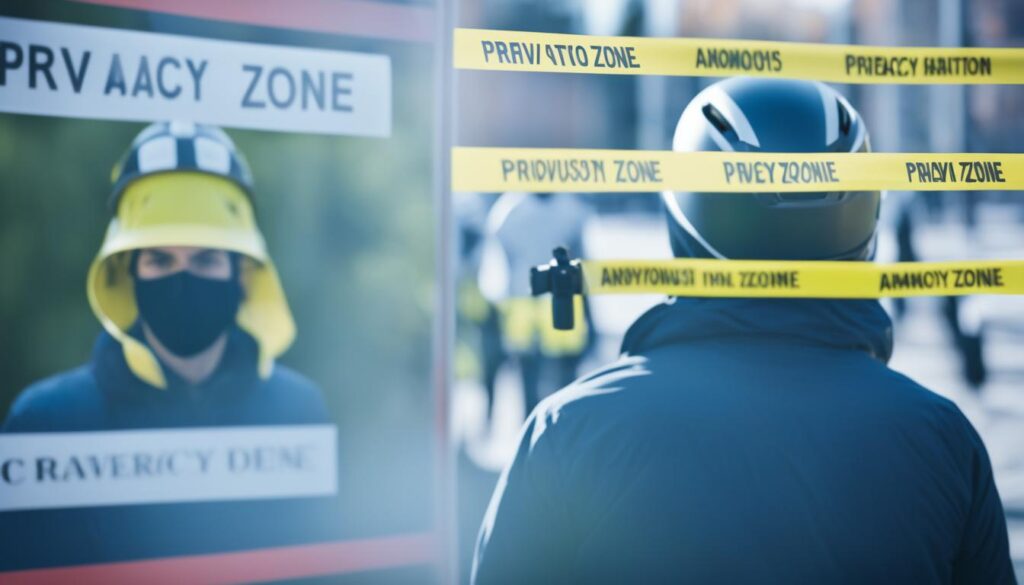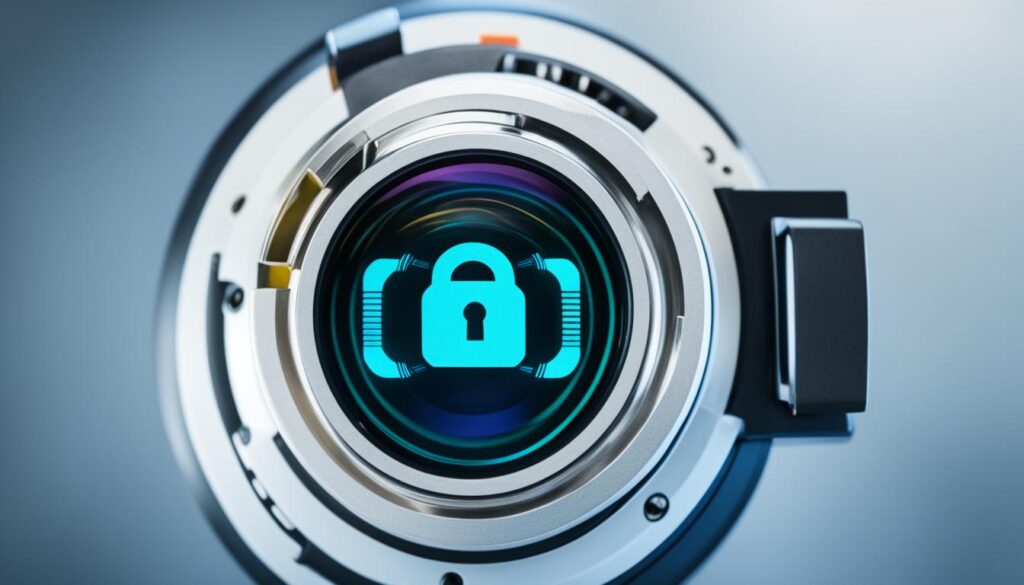
Helmet cameras have revolutionized the way we capture and relive our action-packed adventures. From thrilling mountain biking expeditions to exhilarating skiing trips, these cameras allow us to document our experiences in ways we never thought possible. But have you ever stopped to consider the privacy concerns and ethical considerations that come with helmet camera use?
Are you unknowingly invading someone’s privacy by recording them without their consent? Do you have the right to share footage that includes identifiable information of others? And how can you ensure the security of the data captured by your helmet camera?
In this article, we will explore the complex landscape of privacy and ethics in helmet camera use. We will delve into the relevant regulations and guidelines, uncover practical tips for balancing privacy and safety concerns, and discuss the rights and responsibilities of helmet camera users. Join us on this journey as we navigate the vast terrain of privacy and ethics in the world of helmet cameras.
Key Takeaways:
- Privacy and ethics are essential considerations in helmet camera use.
- Understanding privacy regulations and guidelines is crucial for responsible helmet camera use.
- It is important to strike a balance between capturing moments and respecting the privacy of others.
- Data security and confidentiality should be a top priority when using helmet cameras.
- Developing comprehensive helmet camera policies helps ensure responsible and ethical use.
Understanding Privacy Regulations and Guidelines
When it comes to using helmet cameras, it’s crucial to be aware of and comply with privacy regulations and guidelines. Different jurisdictions have specific laws governing the use of cameras in public or private spaces, as well as the recording and sharing of footage. By understanding and following these privacy regulations, you can protect the privacy of individuals and ensure responsible use of helmet cameras.
Developing comprehensive helmet camera policies that outline best practices for privacy protection is essential. These policies should address important issues such as obtaining consent, redacting or anonymizing footage, and establishing appropriate data retention periods. Adhering to these guidelines will help minimize privacy concerns and promote ethical use of helmet cameras.
If you want to capture and share your helmet camera footage responsibly, it’s crucial to understand and follow privacy regulations. By doing so, you can protect the privacy of others and enjoy the benefits of this exciting technology.
Privacy Regulations and Laws
The specific privacy regulations and laws governing helmet camera use may vary based on your location. Here are some key aspects to consider:
- Recording in Public Spaces: While it is generally permissible to record in public spaces, it is important to respect the privacy of individuals. Avoid capturing footage that invades someone’s privacy or captures sensitive information without their consent.
- Recording in Private Spaces: In most cases, recording in private spaces without consent is considered a violation of privacy. Make sure to obtain the necessary permissions before recording or sharing footage taken in private areas.
- Consent and Release Forms: It is advisable to obtain written consent from individuals before recording and sharing footage that features their identifiable information. Consent forms should clearly explain the purpose of the recording and how the footage will be used.
- Data Retention: Establishing clear guidelines for data retention is crucial. Determine how long recorded footage will be stored and when it will be deleted to ensure that privacy is protected and unnecessary data is not retained.
By incorporating these privacy regulations and guidelines into your helmet camera policies, you can ensure that both your rights and the privacy of others are respected.
Best Practices for Protecting Privacy
Here are some best practices that can help protect privacy when using helmet cameras:
- Obtain Consent: Always ask for consent before recording or sharing footage that includes identifiable information of others. This includes obtaining consent for specific activities or events where filming may occur.
- Redaction or Anonymization: Consider redaction or anonymization techniques to blur or hide the faces or other identifiable details of individuals who did not provide consent. This helps protect the privacy of both individuals and bystanders.
- Data Security: Implement robust data security measures to protect the recorded footage from unauthorized access. This may include password protection, encryption, or secure storage options.
- Comply with Regulations: Stay up to date with the latest privacy regulations for helmet camera use in your jurisdiction. Regularly review and update your policies to ensure compliance with any changes in the law.
| Privacy Regulations and Guidelines | Best Practices |
|---|---|
| Govern the use of cameras in public and private spaces | Obtain consent before recording or sharing identifiable footage |
| Specify rules for recording in different contexts | Redact or anonymize footage to protect privacy |
| Outline requirements for consent and release forms | Implement data security measures for footage protection |
| Define data retention periods | Stay informed about evolving privacy regulations |
Balancing Privacy and Safety Concerns
One of the primary concerns with helmet cameras is the potential invasion of privacy. While these cameras are excellent tools for capturing thrilling moments, it is crucial to strike a balance between documenting experiences and respecting the privacy of others.
When using a helmet camera in public spaces or around individuals, it is essential to ask for consent before recording or sharing footage that includes identifiable information of others. Respecting the privacy rights of individuals is paramount in maintaining ethical standards in helmet camera use.
Ethical guidelines for helmet camera use can help guide users in protecting privacy and ensuring responsible practices. These guidelines should emphasize the importance of respect, consent, and responsible sharing of footage.
By adhering to ethical guidelines and obtaining consent from those around them, helmet camera users can promote a culture of responsible recording and sharing. This not only safeguards privacy but also maintains a positive and respectful environment.
Respecting Privacy and Seeking Consent
When using a helmet camera, it’s crucial to remember that privacy concerns can arise in various situations. Whether participating in activities in public spaces, crowded areas, or private gatherings, it is essential to consider the privacy rights of others.
“Privacy is not something that I’m merely entitled to, it’s an absolute prerequisite.” – Marlon Brando
Seeking consent before recording or sharing footage that includes identifiable information of others is an ethical practice. This ensures that individuals have control over their personal privacy and how they are represented in any recorded material.
Respecting privacy and seeking consent also extends to the sharing of footage. Before posting or distributing any content captured with a helmet camera, it is crucial to obtain consent from those who may be identifiable in the footage.
Ethical Guidelines for Responsible Use
To protect privacy and uphold ethical standards, helmet camera users should follow these guidelines:
- Obtain consent from individuals who may be recorded or included in the footage.
- Respect any posted signage or regulations regarding photography or recording in specific areas.
- Be mindful of capturing or sharing footage that could be considered invasive or harmful to others’ privacy.
- Anonymize or redact identifiable information of individuals when sharing footage, especially in public settings.
- Use footage captured with a helmet camera for personal use or within the bounds of applicable laws and regulations.
By adhering to these ethical guidelines, helmet camera users can protect privacy, maintain trust, and contribute to a responsible and positive culture of recording and sharing experiences.

| Benefits | Risks |
|---|---|
| Unique perspective and immersive footage. | Potential invasion of privacy for individuals in the vicinity. |
| A tool for capturing memorable experiences. | Possible misuse or misrepresentation of recorded footage. |
| Enhanced safety and documentation in high-risk activities. | Unauthorized sharing of sensitive or personal information. |
Ensuring Data Security and Confidentiality
The data captured by helmet cameras is valuable and must be treated with the utmost care to maintain security and confidentiality. Implementing robust measures to safeguard the footage is essential to protect against unauthorized access and potential breaches. Some key steps to ensure data security and confidentiality include:
- Password Protection: Set up strong passwords for accessing helmet camera footage, limiting access to authorized individuals only.
- Encryption: Utilize encryption techniques to secure the stored data, making it unreadable to unauthorized parties.
- Access Control: Restrict access to the footage by implementing access control mechanisms, such as user authentication and role-based permissions.
- Secure Storage: Store recorded data on secure servers or cloud platforms with advanced security features, ensuring protection against data loss or theft.
In addition to these measures, it is crucial to comply with relevant privacy regulations governing the storage, handling, and sharing of recorded data. Each jurisdiction may have specific requirements, and it is essential to stay up to date with the latest regulations to avoid legal implications. Failure to comply with privacy regulations can result in reputational damage and legal liabilities.
“Data breaches can have severe consequences, including reputational damage and legal liabilities.”
By prioritizing data security and confidentiality, helmet camera users can protect themselves and others from potential privacy breaches. It is important to adopt best practices for data protection and adhere to the ethical guidelines that govern the use of helmet cameras.

Protecting Personal and Sensitive Information
Helmet cameras may often capture personal or sensitive information, such as faces, license plates, or private property. To ensure privacy and protect individuals’ rights, it is crucial to take additional measures:
- Consent: Obtain consent from individuals before recording and sharing any footage that includes their identifiable information. Respect their privacy and consider their right to control their personal data.
- Anonymization: Anonymize or redact sensitive information from the footage to prevent the identification of individuals or the disclosure of sensitive details.
- Data Retention: Establish clear policies for the retention of recorded data, ensuring it is stored only for the necessary duration and securely disposed of afterward.
By implementing these measures, helmet camera users can strike a balance between capturing exhilarating moments and respecting the privacy of individuals featured in their footage.
Rights and Responsibilities of Helmet Camera Users
When it comes to using helmet cameras, users have specific rights and responsibilities. It is essential to understand and respect these guidelines to ensure responsible and ethical practices.
Helmet Camera Usage Rights
Helmet camera users have the right to capture their experiences and share them with others. Whether it’s an exhilarating adventure or a memorable event, helmet cameras provide a unique perspective that allows users to relive their moments and share them with friends, family, and online communities.
Ethical Considerations of Helmet Cameras
While capturing and sharing footage with helmet cameras is exciting, it is crucial to be aware of the ethical considerations involved. Users should refrain from using the footage for malicious purposes or invading the privacy of others. Respecting personal boundaries and obtaining consent when recording or sharing footage that includes identifiable information of others is vital.
“Respecting privacy and consent is not only an ethical responsibility but also a legal obligation. It is essential to be mindful of the impact our actions may have on others.”
Privacy Regulations for Helmet Camera Use
To ensure responsible use of helmet cameras, it is important to understand and comply with the privacy regulations that govern their use. Different jurisdictions may have specific laws and regulations concerning the use of cameras in public or private spaces and the recording and sharing of footage. Familiarizing oneself with the applicable privacy regulations will help users navigate the legal landscape surrounding helmet camera use.
| Rights | Responsibilities |
|---|---|
| 1. Capture and share personal experiences. | 1. Respect the privacy and consent of others. |
| 2. Relive moments and create lasting memories. | 2. Use footage responsibly and ethically. |
| 3. Express creativity and share unique perspectives. | 3. Comply with privacy regulations and guidelines. |
By understanding and adhering to the rights and responsibilities of helmet camera users, individuals can enjoy the benefits of capturing their experiences while respecting the privacy and consent of others. Responsible and ethical practices ensure a positive and safe environment for all helmet camera enthusiasts.
Developing Comprehensive Helmet Camera Policies
To navigate privacy and ethics in helmet camera use, it is crucial to develop comprehensive policies that outline best practices for users. These policies should address a range of issues, including obtaining consent, redacting or anonymizing footage, data security measures, and proper handling and sharing of recorded data.
One of the key considerations in developing helmet camera policies is obtaining consent from individuals who may appear in the footage. Users should be required to obtain explicit consent from anyone who is identifiable in the recording before using or sharing the footage. This helps to protect the privacy of individuals and ensures that they have control over how their image is used.
An important aspect of helmet camera policies is the redaction or anonymization of footage. Users should be required to blur or pixelate the faces and other identifying features of individuals who have not provided consent for their images to be recorded or shared. This step helps to further protect privacy and prevent potential harm or misuse of the footage.
Data security is another crucial consideration in helmet camera policies. Users should be educated on security measures such as password protection and encryption to ensure that unauthorized individuals cannot access the recorded footage. Additionally, policies should outline guidelines for the secure storage and handling of recorded data to prevent data breaches and unauthorized use.
Proper handling and sharing of recorded data is essential for maintaining privacy and ethical practices. Helmet camera policies should specify who has access to the recorded footage and under what circumstances it can be shared. Users should be encouraged to share footage responsibly, respecting the privacy and consent of others and avoiding any malicious use or invasion of privacy.
Working with legal professionals can greatly assist in the development of robust helmet camera policies that align with privacy regulations and ethical guidelines. Legal experts can provide insights into applicable laws and regulations, ensuring that policies are compliant and protect the privacy and rights of both users and individuals who may be recorded.
By developing comprehensive helmet camera policies that address consent, redaction or anonymization of footage, data security, and responsible handling and sharing of recorded data, users can ensure the responsible and ethical use of helmet cameras while prioritizing privacy and protecting the rights of individuals.
Educating Users on Privacy and Ethical Guidelines
To ensure responsible use of helmet cameras, it is crucial to educate users on privacy and ethical guidelines. By understanding the potential privacy concerns associated with helmet camera usage and the legal and ethical obligations that come with capturing and sharing footage, users can make informed decisions and contribute to a culture of respect and responsible sharing within the community.
The Importance of Education
Helmet camera users need to be aware of the ethical considerations surrounding their use to ensure they do not infringe upon the privacy of others or engage in unethical practices. Education helps users understand the impact their actions may have and empowers them to make responsible choices with their helmet cameras.
Training Programs
Training programs can play a crucial role in educating helmet camera users. These programs should cover topics such as obtaining consent, respecting privacy, and following ethical guidelines when using helmet cameras. By providing users with the necessary knowledge and skills, training programs can promote responsible helmet camera usage.
Awareness Campaigns
Awareness campaigns can help promote a broader understanding of the privacy regulations and ethical considerations related to helmet camera use. These campaigns can raise awareness about the importance of obtaining consent, respecting privacy boundaries, and using footage responsibly. By reaching a wider audience, awareness campaigns can contribute to a safer and more respectful helmet camera community.
Encouraging Responsible Use
Through education, training, and awareness, helmet camera users can be encouraged to embrace responsible use. By respecting privacy regulations, obtaining consent, and sharing footage responsibly, users can ensure that their enjoyment of helmet cameras does not come at the expense of others’ privacy or ethical considerations.
Conclusion
Navigating privacy and ethics in helmet camera use is crucial for ensuring responsible and ethical practices. As helmet cameras become more popular, it is important to consider the privacy concerns and ethical considerations that arise from their usage. By prioritizing privacy and safety, implementing data security measures, and following privacy regulations and guidelines, users can enjoy capturing their experiences while respecting the rights and privacy of others.
Developing comprehensive helmet camera policies and guidelines is essential to create a framework that promotes responsible use. These policies should address issues such as obtaining consent, protecting privacy, data security, and responsible sharing of recorded footage. Adhering to ethical considerations, such as not using the footage for malicious purposes or invading others’ privacy, is crucial for maintaining trust and respect within the helmet camera community.
Staying informed about evolving privacy regulations and continuously adapting policies and practices is imperative. Privacy regulations for helmet camera use may vary across jurisdictions, and it is essential to comply with the specific laws applicable in your location. By educating users on privacy and ethical guidelines, fostering awareness, and promoting responsible practices, we can navigate the complex landscape of helmet camera usage and ensure the protection of privacy and ethics.
Source Links
- https://ojin.nursingworld.org/table-of-contents/volume-23-2018/number-2-may-2018/electronic-surveillance-of-nurses/
- https://www.linkedin.com/pulse/navigating-complexities-sharing-cctv-footage-legal-eduardo-e-
- https://www.ncbi.nlm.nih.gov/pmc/articles/PMC8320316/

Meet James Smith, affectionately known by friends as ‘Biker Smith’, your go-to expert at ‘Best HD Helmet Camera’. At 35, living in the USA, James embodies the spirit of adventure. His life is a thrilling ride, powered by his Harley Davidson Softail and BMW S 1000 RR, with his girlfriend as his favorite travel companion. A software developer by profession, James’s heart beats for the open road, making him a full-time traveler at heart. His passion for biking and technology merges seamlessly on this platform. Recognizing a gap in discussions around helmet cameras, he founded this blog to educate and inspire fellow enthusiasts. His mission? To elevate your riding experience with the best HD helmet camera insights, backed by firsthand experiences, rigorous testing, and a genuine love for the ride. Trust James to guide you through the world of helmet cameras, where quality, innovation, and safety ride together.